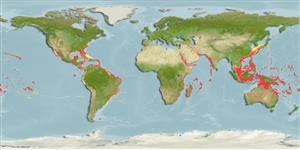Common names from other countries
Environment: milieu / climate zone / depth range / distribution range
Ekologi
; kisaran kedalaman 0 - 139 m (Ref. 81020). Tropical
Indo-Pacific and Western Central Atlantic.
Length at first maturity / Size / Weight / umur
Maturity: Lm ? range ? - ? cm Max length : 8.0 cm WD jantan/; (Ref. 800)
Found subtidally (Ref. 102838). Inhabits hard substrates by boring on rocks in shallow waters (Ref. 800). It is also found on fore-reefs (Ref. 87903). A grazing echinoid, predominantly scraping the substratum of turf algae (Ref. 125618). Feeds on algae (Also Ref. 129602) and small invertebrates. Associated with Athanas indica, which hides between its spines (Ref. 800). Associated with coral communities. Burrowing species (Ref. 129602).
Life cycle and mating behavior
Kematangan | Reproduksi, perkembang biakan | Pemijahan | telur-telur | Fecundity | Larva
Members of the class Echinoidea are gonochoric. Fertilization is external. Brooding is common, eggs are held either on the peristome, around the periproct or deep into the concavities on the petaloids. Life cycle: Embryos develop into planktotrophic larvae (echinoplateus) and live for several months before they sink to the bottom using their tube feet to adhere on the ground where they metamorphose into young urchins.
rujukan utama
Acuan | Koordinator | mitra
Schoppe, S. 2000. (Ref. 800)
Status IUCN Red List (Ref. 130435)
status CITES (Ref. 108899)
Not Evaluated
Not Evaluated
penggunaan manusia
| FishSource |
Alat, peralatan
Sumber internet
Estimates based on models
Preferred temperature
(Ref.
115969): 23.3 - 28.8, mean 27.1 (based on 1386 cells).
Daya lenting
Tinggi, Waktu penggandaan populasi minimum kurang dari 15 bulan (K=0.4).
keancaman
Low vulnerability (10 of 100).
kategori harga
Unknown.
